Shamrock svg.svg on:
[Wikipedia]
[Google]
[Amazon]
 A shamrock is a young sprig, used as a symbol of Ireland.
A shamrock is a young sprig, used as a symbol of Ireland.
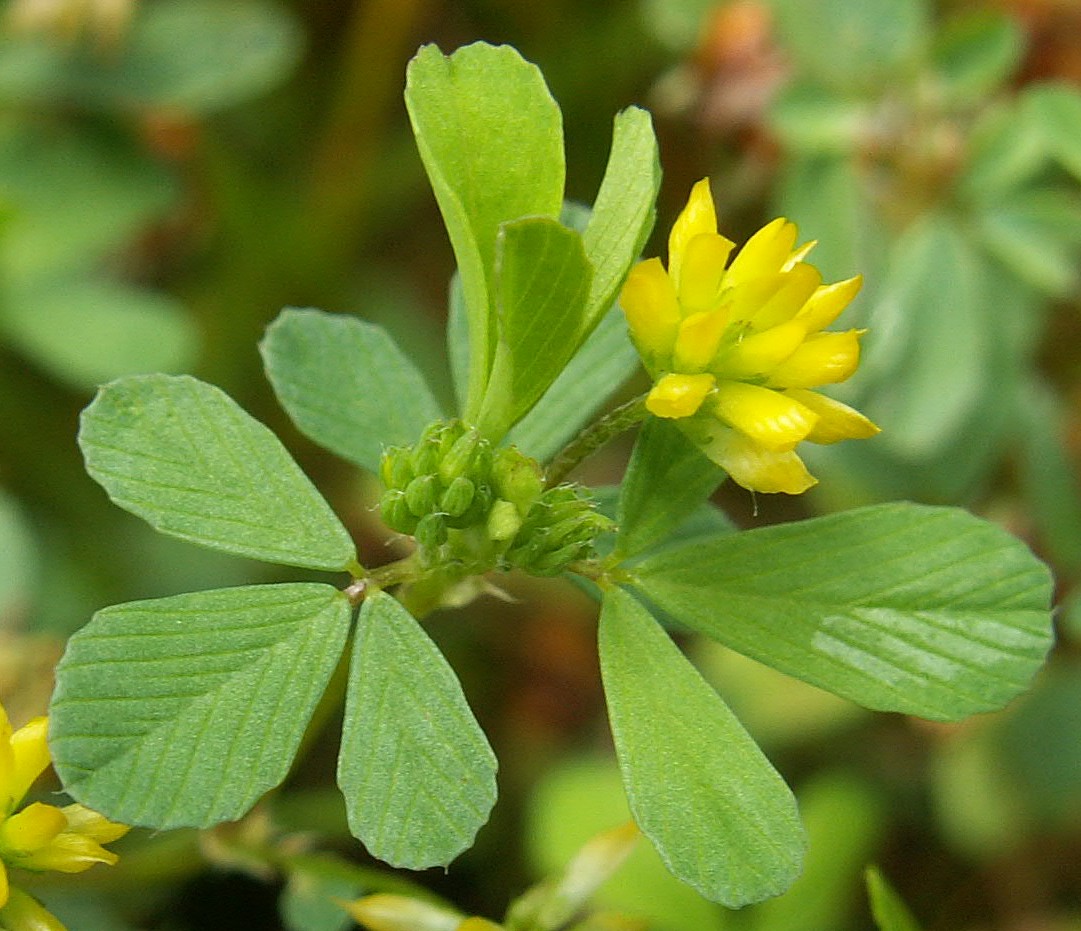 There is still not a consensus over the precise botanical species of clover that is the "true" shamrock. John Gerard in his herbal of 1597 defined the shamrock as ''Trifolium pratense'' or ''Trifolium pratense flore albo'', meaning red or white clover. He described the plant in English as "Three leaved grasse" or "Medow Trefoile", "which are called in Irish ''Shamrockes''". The Irish botanist
There is still not a consensus over the precise botanical species of clover that is the "true" shamrock. John Gerard in his herbal of 1597 defined the shamrock as ''Trifolium pratense'' or ''Trifolium pratense flore albo'', meaning red or white clover. He described the plant in English as "Three leaved grasse" or "Medow Trefoile", "which are called in Irish ''Shamrockes''". The Irish botanist  Linnaeus based his information that the Irish ate shamrock on the comments of English Elizabethan authors such as
Linnaeus based his information that the Irish ate shamrock on the comments of English Elizabethan authors such as 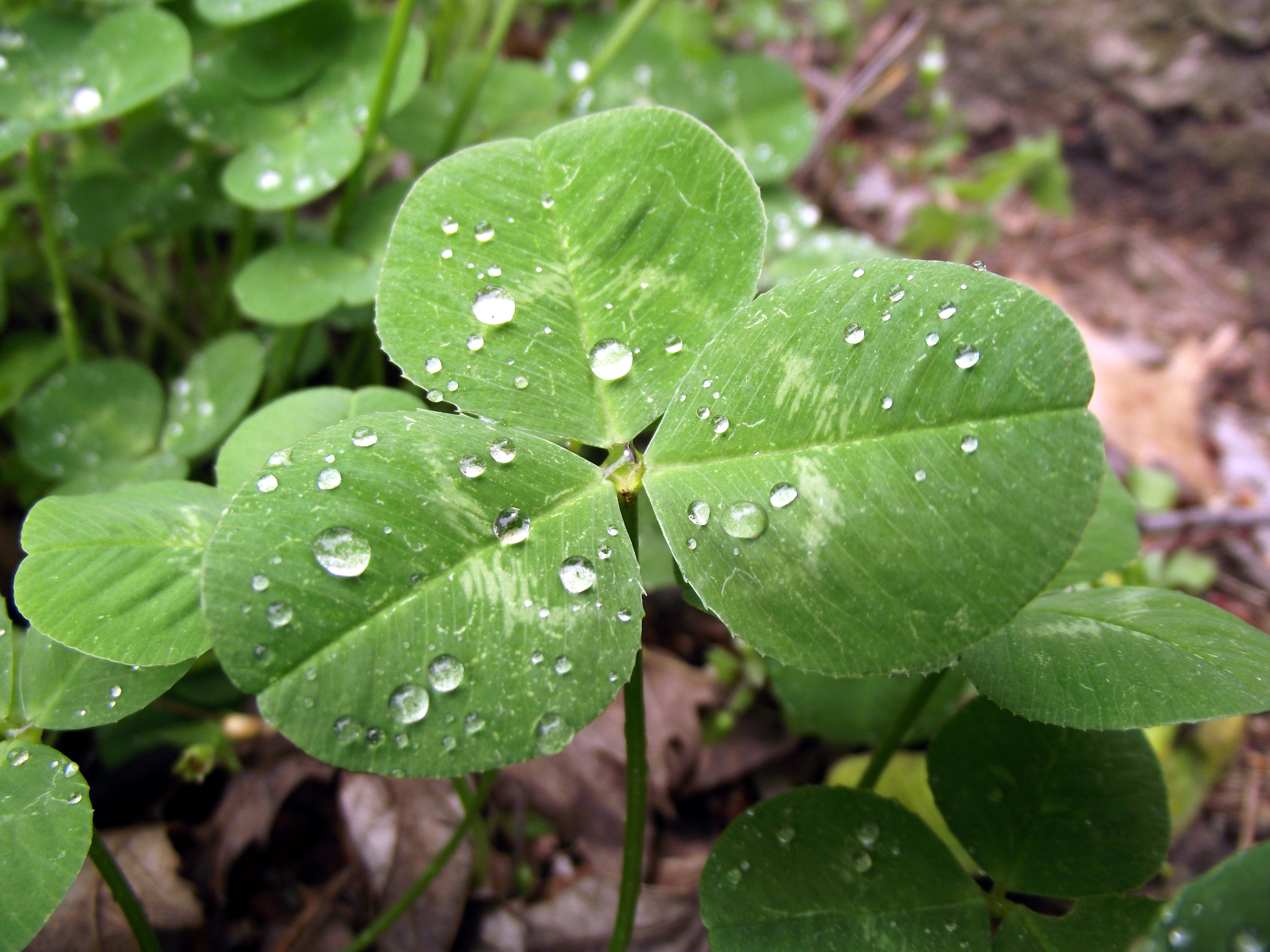 Finally, detailed investigations to settle the matter were carried out in two separate botanical surveys in Ireland, one in 1893 and the other in 1988. The 1893 survey was carried out by Nathaniel Colgan, an amateur naturalist working as a clerk in Dublin; while the 1988 survey was carried out by
Finally, detailed investigations to settle the matter were carried out in two separate botanical surveys in Ireland, one in 1893 and the other in 1988. The 1893 survey was carried out by Nathaniel Colgan, an amateur naturalist working as a clerk in Dublin; while the 1988 survey was carried out by 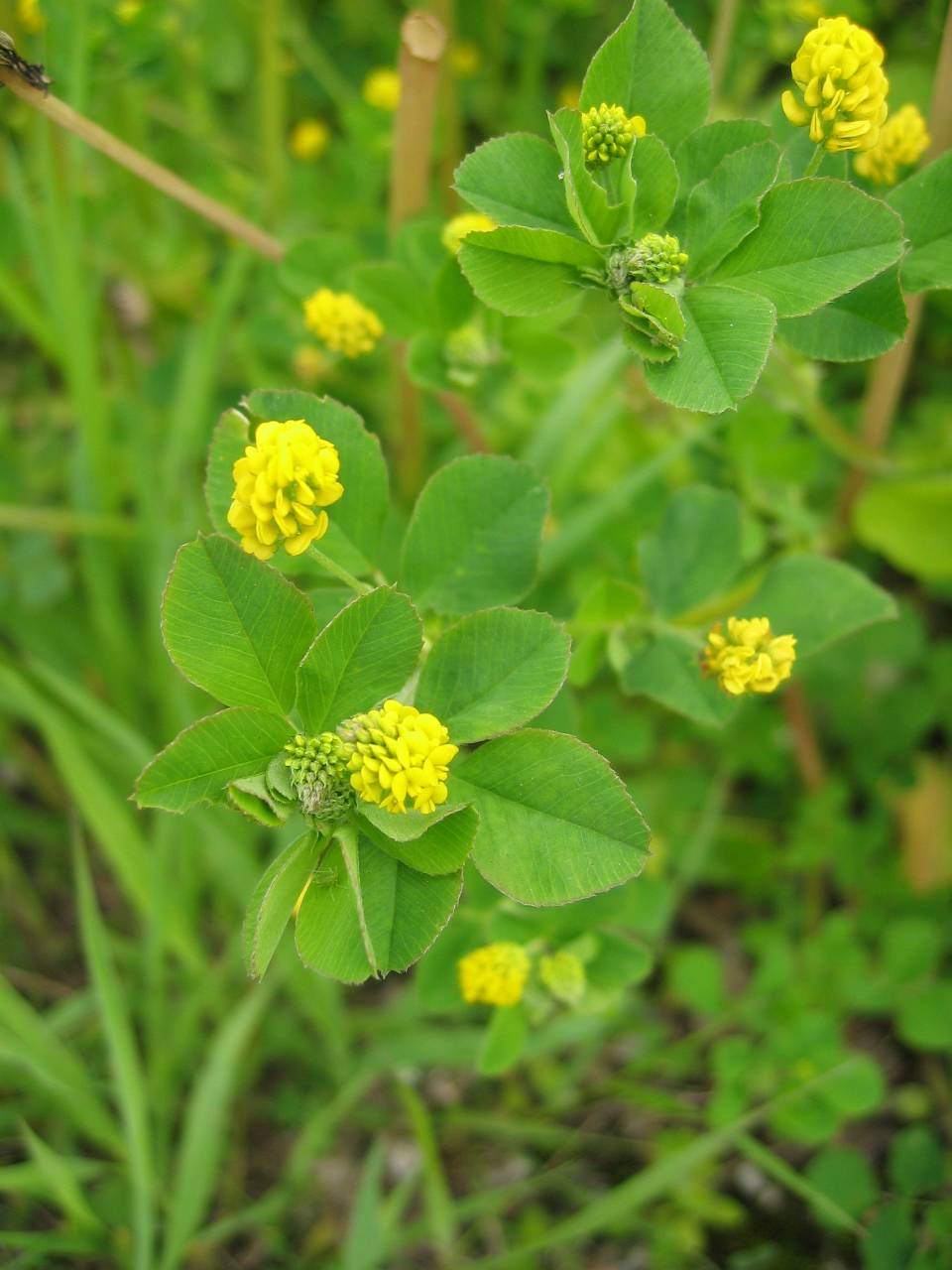 The results show that there is no one "true" species of shamrock, but that ''Trifolium dubium'' (lesser clover) is considered to be the shamrock by roughly half of Irish people, and ''Trifolium repens'' (white clover) by another third, with the remaining sixth split between ''Trifolium pratense'' (red clover), ''Medicago lupulina'' (black medick), ''Oxalis acetosella'' (wood sorrel), and various other species of ''Trifolium'' and ''Oxalis''. None of the species in the survey are unique to Ireland, and all are common European species, so there is no botanical basis for the belief that the shamrock is a unique species of plant that only grows in Ireland.
The results show that there is no one "true" species of shamrock, but that ''Trifolium dubium'' (lesser clover) is considered to be the shamrock by roughly half of Irish people, and ''Trifolium repens'' (white clover) by another third, with the remaining sixth split between ''Trifolium pratense'' (red clover), ''Medicago lupulina'' (black medick), ''Oxalis acetosella'' (wood sorrel), and various other species of ''Trifolium'' and ''Oxalis''. None of the species in the survey are unique to Ireland, and all are common European species, so there is no botanical basis for the belief that the shamrock is a unique species of plant that only grows in Ireland.
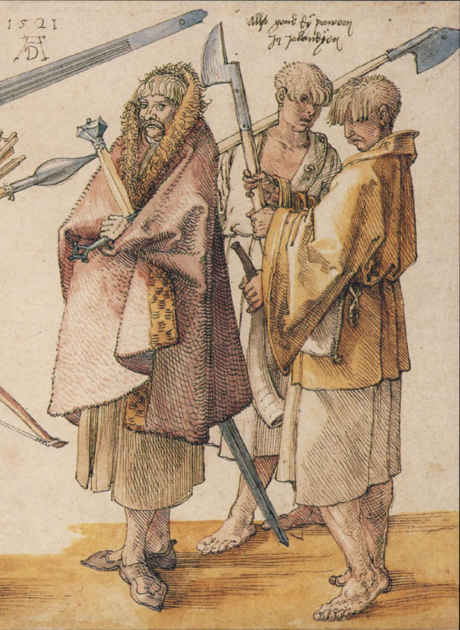 The first mention of shamrock in the English language occurs in 1571 in the work of the English Elizabethan scholar Edmund Campion. In his work ''Boke of the Histories of Irelande'', Campion describes the habits of the "wild Irish" and states that the Irish ate shamrock: "Shamrotes, watercresses, rootes, and other herbes they feed upon". The statement that the Irish ate shamrock was widely repeated in later works and seems to be a confusion with the Irish word ''seamsóg'' or wood sorrel (Oxalis). There is no evidence from any Irish source that the Irish ate clover, but there is evidence that the Irish ate wood sorrel. For example, in the medieval Irish work '' Buile Shuibhne'' (''The Frenzy of Sweeney''), the king Sweeney, who has gone mad and is living in the woods as a hermit, lists wood sorrel among the plants he feeds upon.
The English Elizabethan poet
The first mention of shamrock in the English language occurs in 1571 in the work of the English Elizabethan scholar Edmund Campion. In his work ''Boke of the Histories of Irelande'', Campion describes the habits of the "wild Irish" and states that the Irish ate shamrock: "Shamrotes, watercresses, rootes, and other herbes they feed upon". The statement that the Irish ate shamrock was widely repeated in later works and seems to be a confusion with the Irish word ''seamsóg'' or wood sorrel (Oxalis). There is no evidence from any Irish source that the Irish ate clover, but there is evidence that the Irish ate wood sorrel. For example, in the medieval Irish work '' Buile Shuibhne'' (''The Frenzy of Sweeney''), the king Sweeney, who has gone mad and is living in the woods as a hermit, lists wood sorrel among the plants he feeds upon.
The English Elizabethan poet
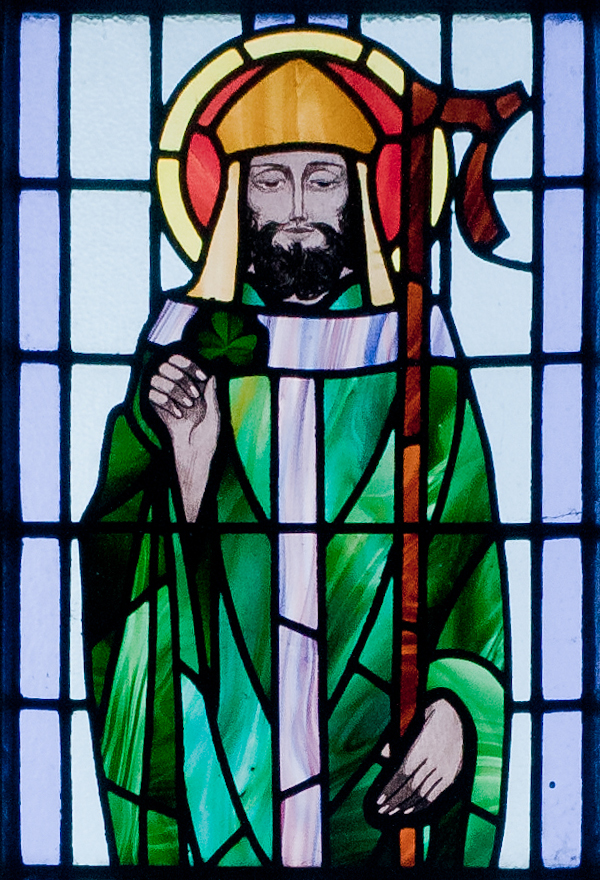 Traditionally, shamrock is said to have been used by
Traditionally, shamrock is said to have been used by
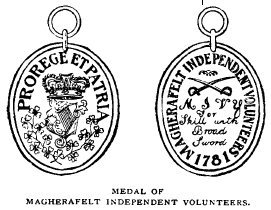 As St. Patrick is Ireland's patron saint, the shamrock has been used as a symbol of Ireland since the 18th century, in a similar way to how a rose is used for England, a thistle for Scotland and a daffodil for Wales. The shamrock first began to evolve from a symbol purely associated with St. Patrick to an Irish national symbol when it was taken up as an emblem by rival militias during the turbulent politics of the late eighteenth century. On one side were the Volunteers (also known as the Irish Volunteers), who were local militias in late 18th century Ireland, raised to defend Ireland from the threat of French and Spanish invasion when regular British soldiers were withdrawn from Ireland to fight during the American Revolutionary War. On the other side were revolutionary nationalist groups, such as the United Irishmen.
Among the Volunteers, examples of the use of the shamrock include its appearance on the guidon of the Royal Glin Hussars formed in July 1779 by the
As St. Patrick is Ireland's patron saint, the shamrock has been used as a symbol of Ireland since the 18th century, in a similar way to how a rose is used for England, a thistle for Scotland and a daffodil for Wales. The shamrock first began to evolve from a symbol purely associated with St. Patrick to an Irish national symbol when it was taken up as an emblem by rival militias during the turbulent politics of the late eighteenth century. On one side were the Volunteers (also known as the Irish Volunteers), who were local militias in late 18th century Ireland, raised to defend Ireland from the threat of French and Spanish invasion when regular British soldiers were withdrawn from Ireland to fight during the American Revolutionary War. On the other side were revolutionary nationalist groups, such as the United Irishmen.
Among the Volunteers, examples of the use of the shamrock include its appearance on the guidon of the Royal Glin Hussars formed in July 1779 by the 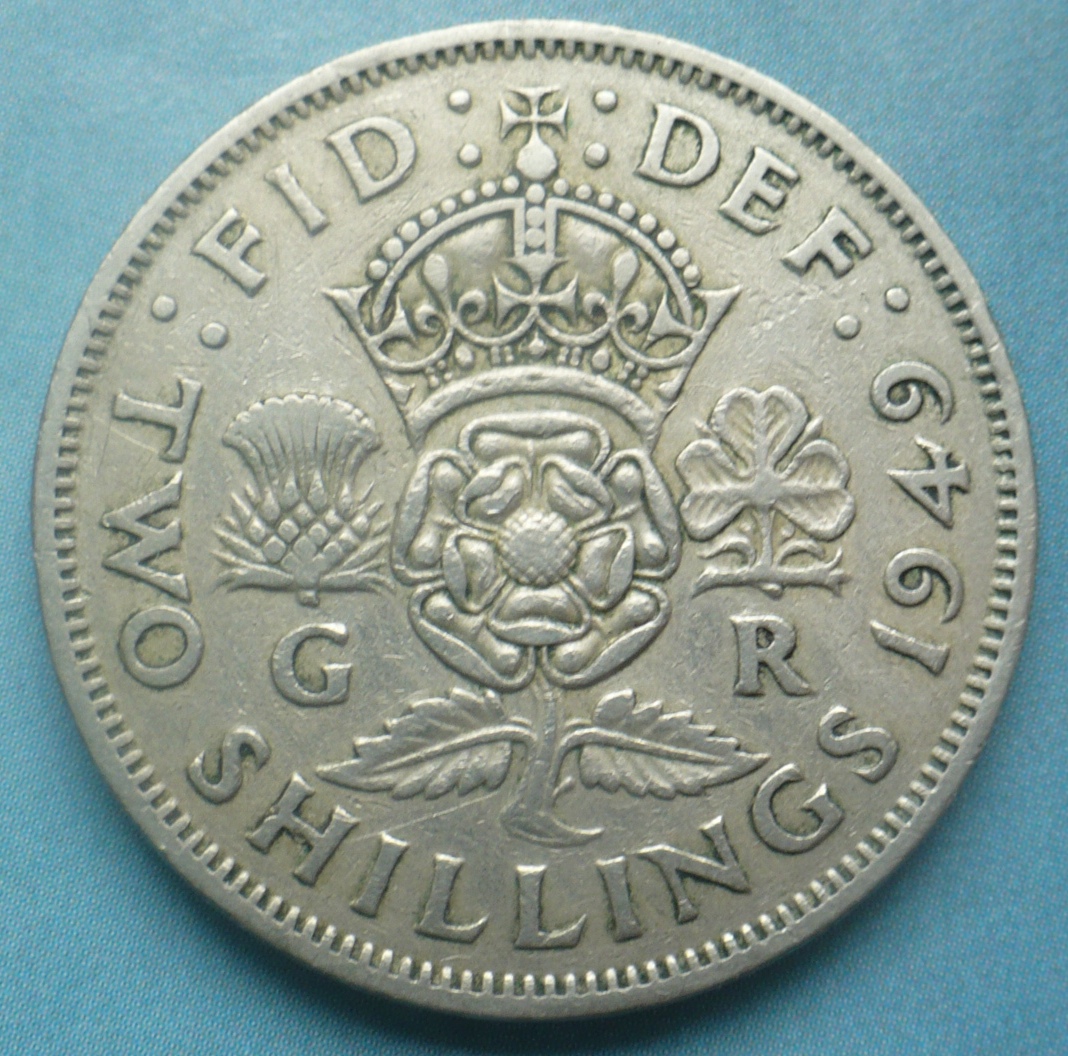 Since the 1800 Acts of Union between Britain and Ireland the shamrock was incorporated into the Royal Coat of Arms of the United Kingdom, depicted growing from a single stem alongside the rose of England, and the thistle of Scotland to symbolise the unity of the three kingdoms. Since then, the shamrock has regularly appeared alongside the rose, thistle and (sometimes)
Since the 1800 Acts of Union between Britain and Ireland the shamrock was incorporated into the Royal Coat of Arms of the United Kingdom, depicted growing from a single stem alongside the rose of England, and the thistle of Scotland to symbolise the unity of the three kingdoms. Since then, the shamrock has regularly appeared alongside the rose, thistle and (sometimes) 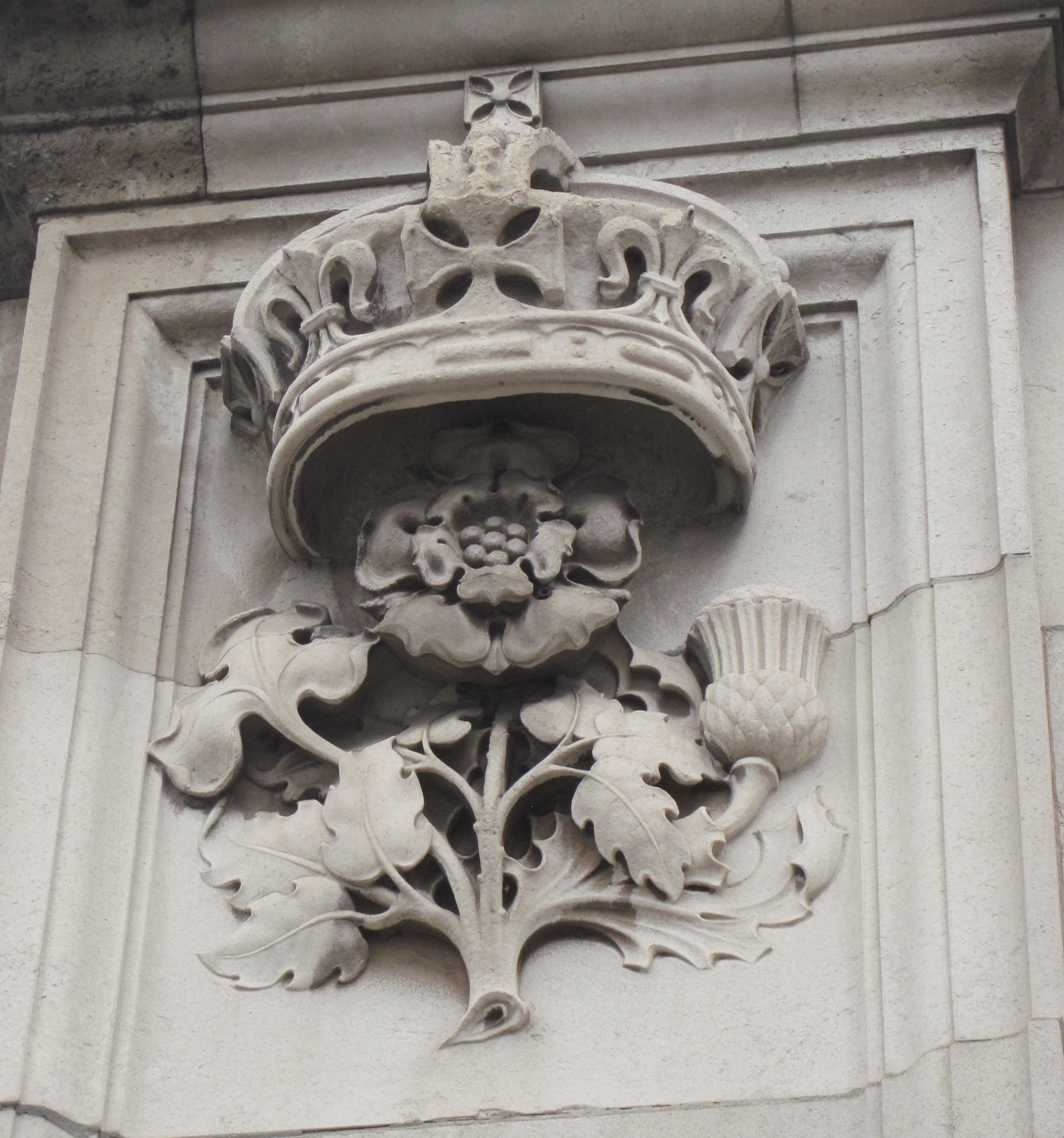
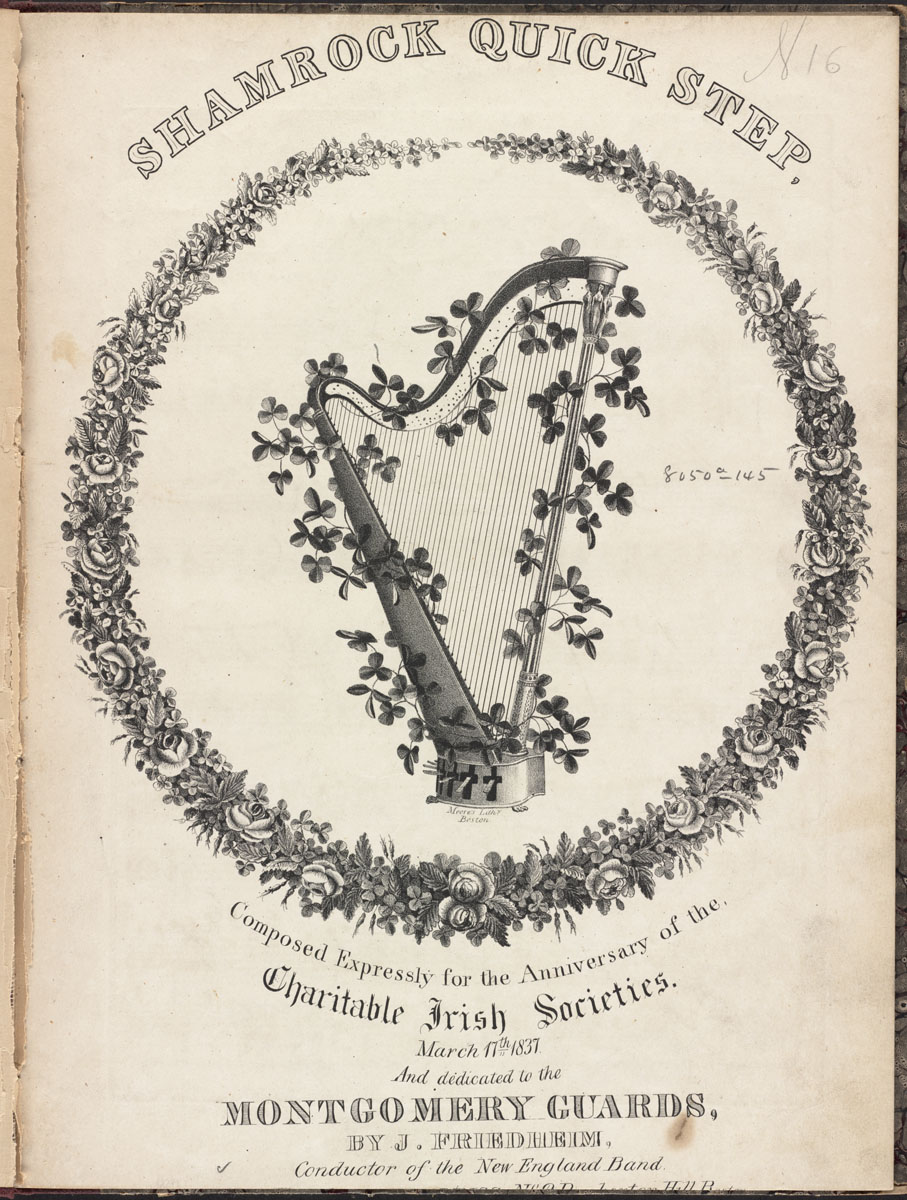
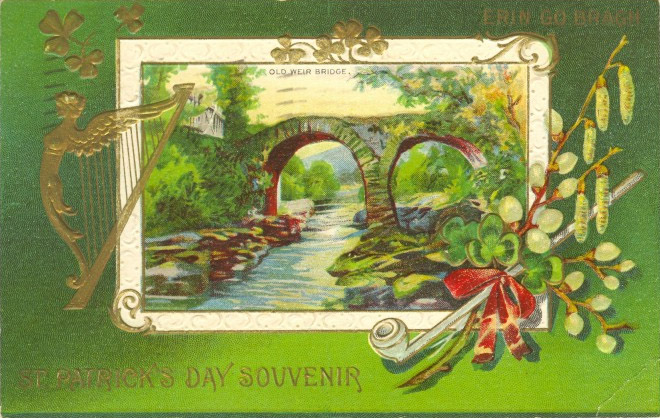 Throughout the nineteenth and twentieth centuries, the shamrock continued to appear in a variety of settings. For example, the shamrock appeared on many buildings in Ireland as a decorative motif, such as on the facade of the Kildare Street Club building in Dublin, St. Patrick's Cathedral, Armagh, and the Harp and Lion Bar in
Throughout the nineteenth and twentieth centuries, the shamrock continued to appear in a variety of settings. For example, the shamrock appeared on many buildings in Ireland as a decorative motif, such as on the facade of the Kildare Street Club building in Dublin, St. Patrick's Cathedral, Armagh, and the Harp and Lion Bar in
File:Mountjoy square lamppost1.jpg, Lamppost in
The shamrock is used in the emblems of many state organisations, both in the Republic of Ireland and Northern Ireland. Some of these are all-Ireland bodies, (such as  The shamrock has been registered as a trademark by the Government of Ireland. In the early 1980s, Ireland defended its right to use the shamrock as its national symbol in a German trademark case, which included high-level representation from Taoiseach Charles Haughey. Having originally lost, Ireland won on appeal to the German Supreme Court in 1985.
It has become a tradition for the Irish Taoiseach to present a bowl of shamrocks in a special Waterford Crystal bowl featuring a shamrock design to the President of the United States in the White House every St. Patrick's Day.
Shamrock is also used in emblems of UK organisations with an association with Ireland, such as the Irish Guards. Soldiers of the Royal Irish Regiment of the British Army use the shamrock as their emblem, and wear a sprig of shamrock on Saint Patrick's Day. Shamrock are exported to wherever the regiment is stationed throughout the world. Queen Victoria decreed over a hundred years ago that soldiers from Ireland should wear a sprig of shamrock in recognition of fellow Irish soldiers who had fought bravely in the Boer War, a tradition continued by British army soldiers from both the north and the south of Ireland following
The shamrock has been registered as a trademark by the Government of Ireland. In the early 1980s, Ireland defended its right to use the shamrock as its national symbol in a German trademark case, which included high-level representation from Taoiseach Charles Haughey. Having originally lost, Ireland won on appeal to the German Supreme Court in 1985.
It has become a tradition for the Irish Taoiseach to present a bowl of shamrocks in a special Waterford Crystal bowl featuring a shamrock design to the President of the United States in the White House every St. Patrick's Day.
Shamrock is also used in emblems of UK organisations with an association with Ireland, such as the Irish Guards. Soldiers of the Royal Irish Regiment of the British Army use the shamrock as their emblem, and wear a sprig of shamrock on Saint Patrick's Day. Shamrock are exported to wherever the regiment is stationed throughout the world. Queen Victoria decreed over a hundred years ago that soldiers from Ireland should wear a sprig of shamrock in recognition of fellow Irish soldiers who had fought bravely in the Boer War, a tradition continued by British army soldiers from both the north and the south of Ireland following
File:Erin Go Bragh Banner.svg, Flag of St. Patrick's Battalion of the Mexican army reconstructed from description of Jon Riley
File:Flag of Montreal.svg, The
The truth behind the shamrock
on the BBC News website, dated 17 March 2004. Retrieved 2008-07-20
on the About.com website. Retrieved 2008-07-20
www.decodeunicode.org/en/u+2618
Shamrock as a symbol in Unicode Christian symbols Trinitarianism Irish-American culture Irish culture Irish folklore National symbols of Ireland National symbols of Northern Ireland
 A shamrock is a young sprig, used as a symbol of Ireland.
A shamrock is a young sprig, used as a symbol of Ireland. Saint Patrick
Saint Patrick ( la, Patricius; ga, Pádraig ; cy, Padrig) was a fifth-century Romano-British Christian missionary and bishop in Ireland. Known as the "Apostle of Ireland", he is the primary patron saint of Ireland, the other patron saints be ...
, Ireland's patron saint, is said to have used it as a metaphor for the Christian Holy Trinity
The Christian doctrine of the Trinity (, from 'threefold') is the central dogma concerning the nature of God in most Christian churches, which defines one God existing in three coequal, coeternal, consubstantial divine persons: God the F ...
. The name ''shamrock'' comes from Irish (), which is the diminutive
A diminutive is a root word that has been modified to convey a slighter degree of its root meaning, either to convey the smallness of the object or quality named, or to convey a sense of intimacy or endearment. A (abbreviated ) is a word-formati ...
of the Irish word and simply means "young clover".
At most times'', Shamrock'' refers to either the species (lesser clover, Irish: ) or (white clover, Irish: ). However, other three-leaved plants—such as , , and —are sometimes called shamrocks. The shamrock was traditionally used for its medicinal properties and was a popular motif
Motif may refer to:
General concepts
* Motif (chess composition), an element of a move in the consideration of its purpose
* Motif (folkloristics), a recurring element that creates recognizable patterns in folklore and folk-art traditions
* Moti ...
in Victorian
Victorian or Victorians may refer to:
19th century
* Victorian era, British history during Queen Victoria's 19th-century reign
** Victorian architecture
** Victorian house
** Victorian decorative arts
** Victorian fashion
** Victorian literature ...
times.
Botanical species
 There is still not a consensus over the precise botanical species of clover that is the "true" shamrock. John Gerard in his herbal of 1597 defined the shamrock as ''Trifolium pratense'' or ''Trifolium pratense flore albo'', meaning red or white clover. He described the plant in English as "Three leaved grasse" or "Medow Trefoile", "which are called in Irish ''Shamrockes''". The Irish botanist
There is still not a consensus over the precise botanical species of clover that is the "true" shamrock. John Gerard in his herbal of 1597 defined the shamrock as ''Trifolium pratense'' or ''Trifolium pratense flore albo'', meaning red or white clover. He described the plant in English as "Three leaved grasse" or "Medow Trefoile", "which are called in Irish ''Shamrockes''". The Irish botanist Caleb Threlkeld
Caleb Threlkeld (1676–1728) was an Irish botanist, dissenting cleric and physician
A physician (American English), medical practitioner (Commonwealth English), medical doctor, or simply doctor, is a health professional who practices ...
, writing in 1726 in his work entitled ''Synopsis Stirpium Hibernicarum'' or ''A Treatise on Native Irish Plants'' followed Gerard in identifying the shamrock as ''Trifolium pratense'', calling it White Field Clover.
The botanist Carl Linnaeus in his 1737 work '' Flora Lapponica'' identifies the shamrock as ''Trifolium pratense'', mentioning it by name as ''Chambroch'', with the following curious remark: "''Hiberni suo Chambroch, quod est Trifolium pratense purpureum, aluntur, celeres & promtissimi roburis''" (The Irish call it shamrock, which is purple field clover, and which they eat to make them speedy and of nimble strength).
 Linnaeus based his information that the Irish ate shamrock on the comments of English Elizabethan authors such as
Linnaeus based his information that the Irish ate shamrock on the comments of English Elizabethan authors such as Edmund Spenser
Edmund Spenser (; 1552/1553 – 13 January 1599) was an English poet best known for ''The Faerie Queene'', an epic poem and fantastical allegory celebrating the Tudor dynasty and Elizabeth I. He is recognized as one of the premier craftsmen of ...
who remarked that the shamrock used to be eaten by the Irish, especially in times of hardship and famine. It has since been argued however, that the Elizabethans were confused by the similarity between the Irish (Gaelic) name for young clover ''seamróg'', and the name for wood sorrel ''seamsóg''.Kelly, Fergus, ''Early Irish Farming'', (2000), Dublin, p 311
The situation regarding the identity of the shamrock was further confused by a London botanist James Ebenezer Bicheno, who proclaimed in a dissertation in 1830 that the real shamrock was ''Oxalis acetosella'', a species of wood sorrel. Bichino falsely claimed that clover was not a native Irish plant and had only been introduced into Ireland in the middle of the 17th century, and based his argument on the same comments by Elizabethan authors that shamrock had been eaten. Bicheno argued that this fitted the wood sorrel better than clover, as wood sorrel was often eaten as a green and used to flavour food. Bicheno's argument has not been generally accepted however, as the weight of evidence favours a species of clover.
A more scientific approach was taken by English botanists James Britten and Robert Holland, who stated in their ''Dictionary of English Plant Names'' published in 1878, that their investigations had revealed that ''Trifolium dubium'' was the species sold most frequently in Covent Garden
Covent Garden is a district in London, on the eastern fringes of the West End, between St Martin's Lane and Drury Lane. It is associated with the former fruit-and-vegetable market in the central square, now a popular shopping and tourist si ...
as shamrock on St. Patrick's Day
Saint Patrick's Day, or the Feast of Saint Patrick ( ga, Lá Fhéile Pádraig, lit=the Day of the Festival of Patrick), is a cultural and religious celebration held on 17 March, the traditional death date of Saint Patrick (), the foremost patr ...
, and that it was worn in at least 13 counties in Ireland.
 Finally, detailed investigations to settle the matter were carried out in two separate botanical surveys in Ireland, one in 1893 and the other in 1988. The 1893 survey was carried out by Nathaniel Colgan, an amateur naturalist working as a clerk in Dublin; while the 1988 survey was carried out by
Finally, detailed investigations to settle the matter were carried out in two separate botanical surveys in Ireland, one in 1893 and the other in 1988. The 1893 survey was carried out by Nathaniel Colgan, an amateur naturalist working as a clerk in Dublin; while the 1988 survey was carried out by E. Charles Nelson
(Ernest) Charles Nelson (15 September 1951, Belfast, Northern Ireland) is a botanist who specialises in the heather family, Ericaceae, especially ''Erica'', and whose past research interests included the Proteaceae especially '' Adenanthos''. H ...
, Director of the Irish National Botanic Gardens. Both surveys involved asking people from all across Ireland to send in examples of shamrock, which were then planted and allowed to flower, so that their botanical species could be identified. The results of both surveys were very similar, showing that the conception of the shamrock in Ireland had changed little in almost a hundred years. The results of the surveys are shown in the table below.
 The results show that there is no one "true" species of shamrock, but that ''Trifolium dubium'' (lesser clover) is considered to be the shamrock by roughly half of Irish people, and ''Trifolium repens'' (white clover) by another third, with the remaining sixth split between ''Trifolium pratense'' (red clover), ''Medicago lupulina'' (black medick), ''Oxalis acetosella'' (wood sorrel), and various other species of ''Trifolium'' and ''Oxalis''. None of the species in the survey are unique to Ireland, and all are common European species, so there is no botanical basis for the belief that the shamrock is a unique species of plant that only grows in Ireland.
The results show that there is no one "true" species of shamrock, but that ''Trifolium dubium'' (lesser clover) is considered to be the shamrock by roughly half of Irish people, and ''Trifolium repens'' (white clover) by another third, with the remaining sixth split between ''Trifolium pratense'' (red clover), ''Medicago lupulina'' (black medick), ''Oxalis acetosella'' (wood sorrel), and various other species of ''Trifolium'' and ''Oxalis''. None of the species in the survey are unique to Ireland, and all are common European species, so there is no botanical basis for the belief that the shamrock is a unique species of plant that only grows in Ireland.
Early references
The word shamrock derives from ''seamair óg'' or young clover, and references to ''semair'' or clover appear in early Irish literature, generally as a description of a flowering clovered plain. For example, in the series of medieval metrical poems about various Irish places called theMetrical Dindshenchus
''Dindsenchas'' or ''Dindshenchas'' (modern spellings: ''Dinnseanchas'' or ''Dinnsheanchas'' or ''Dınnṡeanċas''), meaning "lore of places" (the modern Irish word ''dinnseanchas'' means "topography"), is a class of onomastic text in early Irish ...
, a poem about Tailtiu or Teltown in Co. Meath describes it as a plain blossoming with flowering clover (''mag scothach scothshemrach''). Similarly, another story tells of how St. Brigid
Saint Brigid of Kildare or Brigid of Ireland ( ga, Naomh Bríd; la, Brigida; 525) is the patroness saint (or 'mother saint') of Ireland, and one of its three national saints along with Patrick and Columba. According to medieval Irish hagiogr ...
decided to stay in Co. Kildare when she saw the delightful plain covered in clover blossom (''scoth-shemrach''). However, the literature in Irish makes no distinction between clover and shamrock, and it is only in English that shamrock emerges as a distinct word.
 The first mention of shamrock in the English language occurs in 1571 in the work of the English Elizabethan scholar Edmund Campion. In his work ''Boke of the Histories of Irelande'', Campion describes the habits of the "wild Irish" and states that the Irish ate shamrock: "Shamrotes, watercresses, rootes, and other herbes they feed upon". The statement that the Irish ate shamrock was widely repeated in later works and seems to be a confusion with the Irish word ''seamsóg'' or wood sorrel (Oxalis). There is no evidence from any Irish source that the Irish ate clover, but there is evidence that the Irish ate wood sorrel. For example, in the medieval Irish work '' Buile Shuibhne'' (''The Frenzy of Sweeney''), the king Sweeney, who has gone mad and is living in the woods as a hermit, lists wood sorrel among the plants he feeds upon.
The English Elizabethan poet
The first mention of shamrock in the English language occurs in 1571 in the work of the English Elizabethan scholar Edmund Campion. In his work ''Boke of the Histories of Irelande'', Campion describes the habits of the "wild Irish" and states that the Irish ate shamrock: "Shamrotes, watercresses, rootes, and other herbes they feed upon". The statement that the Irish ate shamrock was widely repeated in later works and seems to be a confusion with the Irish word ''seamsóg'' or wood sorrel (Oxalis). There is no evidence from any Irish source that the Irish ate clover, but there is evidence that the Irish ate wood sorrel. For example, in the medieval Irish work '' Buile Shuibhne'' (''The Frenzy of Sweeney''), the king Sweeney, who has gone mad and is living in the woods as a hermit, lists wood sorrel among the plants he feeds upon.
The English Elizabethan poet Edmund Spenser
Edmund Spenser (; 1552/1553 – 13 January 1599) was an English poet best known for ''The Faerie Queene'', an epic poem and fantastical allegory celebrating the Tudor dynasty and Elizabeth I. He is recognized as one of the premier craftsmen of ...
, writing soon after in 1596, described his observations of war-torn Munster after the Desmond Rebellion
The Desmond Rebellions occurred in 1569–1573 and 1579–1583 in the Irish province of Munster.
They were rebellions by the Earl of Desmond, the head of the Fitzmaurice/FitzGerald Dynasty in Munster, and his followers, the Geraldines and t ...
in his work ''A View of the Present State of Ireland''. Here shamrock is described as a food eaten as a last resort by starving people desperate for any nourishment during a post-war famine: Anatomies of death, they spake like ghosts, crying out of theire graves; they did eat of the carrions .... and if they found a plott of water cresses or shamrockes theyr they flocked as to a feast for the time, yett not able long to contynewe therewithall.The idea that the Irish ate shamrock is repeated in the writing of
Fynes Moryson
Fynes Moryson (or Morison) (1566 – 12 February 1630) spent most of the decade of the 1590s travelling on the European continent and the eastern Mediterranean lands. He wrote about it later in his multi-volume ''Itinerary'', a work of value to ...
, one-time secretary to the Lord Deputy of Ireland
The Lord Deputy was the representative of the monarch and head of the Irish executive (government), executive under English rule, during the Lordship of Ireland and then the Kingdom of Ireland. He deputised prior to 1523 for the Viceroy of Ireland ...
. In his 1617 work ''An itinerary thorow Twelve Dominions'', Moryson describes the "wild Irish", and in this case their supposed habit of eating shamrock is a result of their marginal hand-to-mouth existence as bandits. Moryson claims that the Irish "willingly eat the herbe Schamrock being of a sharpe taste which as they run and are chased to and fro they snatch like beasts out of the ditches." The reference to a sharp taste is suggestive of the bitter taste of wood sorrel.
What is clear is that by the end of the sixteenth century the shamrock had become known to English writers as a plant particularly associated with the Irish, but only with a confused notion that the shamrock was a plant eaten by them. To a herbalist like Gerard it is clear that the shamrock is clover, but other English writers do not appear to know the botanical identity of the shamrock. This is not surprising, as they probably received their information at second or third hand. It is notable that there is no mention anywhere in these writings of St. Patrick or the legend of his using the shamrock to explain the Holy Trinity. However, there are two possible references to the custom of "drowning the shamrock" in "usquebagh" or whiskey. In 1607, the playwright Edward Sharpham
Edward Sharpham (baptised 1576 – 1608) was an English playwright and pamphleteer.
Life
He was baptised on 22 July 1576, the third son of Richard Sharpham of Colehanger, a manor in the parish of East Allington. His father having died when Sharph ...
in his play ''The Fleire'' included a reference to "Maister Oscabath the Irishman ... and Maister Shamrough his lackey". Later, a 1630 work entitled ''Sir Gregory Nonsence'' by the poet John Taylor John Taylor, Johnny Taylor or similar may refer to:
Academics
*John Taylor (Oxford), Vice-Chancellor of Oxford University, 1486–1487
*John Taylor (classical scholar) (1704–1766), English classical scholar
*John Taylor (English publisher) (178 ...
contains the lines: "Whilste all the Hibernian Kernes in multitudes, /Did feast with shamerags steeved in Usquebagh."
Link to St. Patrick
 Traditionally, shamrock is said to have been used by
Traditionally, shamrock is said to have been used by Saint Patrick
Saint Patrick ( la, Patricius; ga, Pádraig ; cy, Padrig) was a fifth-century Romano-British Christian missionary and bishop in Ireland. Known as the "Apostle of Ireland", he is the primary patron saint of Ireland, the other patron saints be ...
to illustrate the Christian doctrine of the Holy Trinity
The Christian doctrine of the Trinity (, from 'threefold') is the central dogma concerning the nature of God in most Christian churches, which defines one God existing in three coequal, coeternal, consubstantial divine persons: God the F ...
when Christianising Ireland in the 5th century. The first evidence of a link between St Patrick and the shamrock appears in 1675 on the St Patrick's Coppers or Halpennies. These appear to show a figure of St Patrick preaching to a crowd while holding a shamrock, presumably to explain the doctrine of the Holy Trinity. When Saint Patrick arrived in Ireland in 431, he used the shamrock to teach pagans the Holy Trinity. In pagan Ireland, three was a significant number and the Irish had many triple deities, which could have aided St Patrick in his evangelisation efforts. Patricia Monaghan states that "There is no evidence that the clover or wood sorrel (both of which are called shamrocks) were sacred to the Celts". However, Jack Santino speculates that "The shamrock was probably associated with the earth and assumed by the druids to be symbolic of the regenerative powers of nature ... Nevertheless, the shamrock, whatever its history as a folk symbol, today has its meaning in a Christian context. Pictures of Saint Patrick depict him driving the snakes out of Ireland with a cross in one hand and a sprig of shamrocks in the other." Roger Homan writes, "We can perhaps see St Patrick drawing upon the visual concept of the '' triskele'' when he uses the shamrock to explain the Trinity". Why the Celts to whom St Patrick was preaching would have needed an explanation of the concept of a triple deity is not clear (two separate triple goddesses
A triple deity is a deity with three apparent forms that function as a singular whole. Such deities may sometimes be referred to as threefold, tripled, triplicate, tripartite, triune, triadic, or as a trinity. The number three has a long histor ...
are known to have been worshipped in pagan Ireland).
The first written mention of the link does not appear until 1681, in the account of Thomas Dineley, an English traveller to Ireland. Dineley writes:The 17th day of March yeerly is St Patricks, an immoveable feast, when ye Irish of all stations and condicions were crosses in their hatts, some of pinns, some of green ribbon, and the vulgar superstitiously wear shamroges, 3 leav'd grass, which they likewise eat (they say) to cause a sweet breath.There is nothing in Dineley's account of the legend of St. Patrick using the shamrock to teach the mystery of the Holy Trinity, and this story does not appear in writing anywhere until a 1726 work by the botanist
Caleb Threlkeld
Caleb Threlkeld (1676–1728) was an Irish botanist, dissenting cleric and physician
A physician (American English), medical practitioner (Commonwealth English), medical doctor, or simply doctor, is a health professional who practices ...
. Threlkeld identifies the shamrock as White Field Clover (''Trifolium pratense album'' ) and comments rather acerbically on St. Patrick's Day customs including the wearing of shamrocks:This plant is worn by the people in their hats upon the 17. Day of March yearly, (which is called St. Patrick's Day.) It being a current tradition, that by this Three Leafed Grass, he emblematically set forth to them the Mystery of the Holy Trinity. However that be, when they wet their Seamar-oge, they often commit excess in liquor, which is not a right keeping of a day to the Lord; error generally leading to debauchery.The Rev Threlkeld's remarks on liquor undoubtedly refer to the custom of toasting St. Patrick's memory with "St. Patrick's Pot", or "drowning the shamrock" as it is otherwise known. After mass on St. Patrick's Day the traditional custom of the menfolk was to lift the usual fasting restrictions of
Lent
Lent ( la, Quadragesima, 'Fortieth') is a solemn religious observance in the liturgical calendar commemorating the 40 days Jesus spent fasting in the desert and enduring temptation by Satan, according to the Gospels of Matthew, Mark and Luke ...
and repair to the nearest tavern to mark the occasion with as many St. Patrick's Pots as they deemed necessary. The drowning of the shamrock was accompanied by a certain amount of ritual as one account explains:
"The drowning of the shamrock" by no means implies it was necessary to get drunk in doing so. At the end of the day the shamrock which has been worn in the coat or the hat is removed and put into the final glass of grog or tumbler of punch; and when the health has been drunk or the toast honoured, the shamrock should be picked out from the bottom of the glass and thrown over the left shoulder.The shamrock is still chiefly associated with Saint Patrick's Day, which has become the Irish national holiday, and is observed with parades and celebrations worldwide. The custom of wearing shamrock on the day is still observed and depictions of shamrocks are habitually seen during the celebrations.
Symbol of Ireland
 As St. Patrick is Ireland's patron saint, the shamrock has been used as a symbol of Ireland since the 18th century, in a similar way to how a rose is used for England, a thistle for Scotland and a daffodil for Wales. The shamrock first began to evolve from a symbol purely associated with St. Patrick to an Irish national symbol when it was taken up as an emblem by rival militias during the turbulent politics of the late eighteenth century. On one side were the Volunteers (also known as the Irish Volunteers), who were local militias in late 18th century Ireland, raised to defend Ireland from the threat of French and Spanish invasion when regular British soldiers were withdrawn from Ireland to fight during the American Revolutionary War. On the other side were revolutionary nationalist groups, such as the United Irishmen.
Among the Volunteers, examples of the use of the shamrock include its appearance on the guidon of the Royal Glin Hussars formed in July 1779 by the
As St. Patrick is Ireland's patron saint, the shamrock has been used as a symbol of Ireland since the 18th century, in a similar way to how a rose is used for England, a thistle for Scotland and a daffodil for Wales. The shamrock first began to evolve from a symbol purely associated with St. Patrick to an Irish national symbol when it was taken up as an emblem by rival militias during the turbulent politics of the late eighteenth century. On one side were the Volunteers (also known as the Irish Volunteers), who were local militias in late 18th century Ireland, raised to defend Ireland from the threat of French and Spanish invasion when regular British soldiers were withdrawn from Ireland to fight during the American Revolutionary War. On the other side were revolutionary nationalist groups, such as the United Irishmen.
Among the Volunteers, examples of the use of the shamrock include its appearance on the guidon of the Royal Glin Hussars formed in July 1779 by the Knight of Glin
The Knight of Glin (; dormant 14 September 2011), also known as the Black Knight or Knight of the Valley, was a hereditary title held by the FitzGerald and FitzMaurice families of County Limerick, Ireland, since the early 14th century. The fam ...
, and its appearance on the flags of the Limerick Volunteers, the Castle Ray Fencibles and the Braid Volunteers. The United Irishmen adopted green as their revolutionary colour and wore green uniforms or ribbons in their hats, and the green concerned was often associated with the shamrock. The song ''The Wearing of the Green
"The Wearing of the Green" is an Irish street ballad lamenting the repression of supporters of the Irish Rebellion of 1798. It is to an old Irish air, and many versions of the lyric exist, the best-known being by Dion Boucicault. The song proclai ...
'' commemorated their exploits and various versions exist which mention the shamrock. The Erin go bragh flag was used as their standard and was often depicted accompanied by shamrocks, and in 1799 a revolutionary journal entitled ''The Shamroc'' briefly appeared in which the aims of the rebellion were supported.
leek
The leek is a vegetable, a cultivar of ''Allium ampeloprasum'', the broadleaf wild leek ( syn. ''Allium porrum''). The edible part of the plant is a bundle of leaf sheaths that is sometimes erroneously called a stem or stalk. The genus ''Alli ...
for Wales in British coins
The standard circulating coinage of the United Kingdom, British Crown Dependencies and British Overseas Territories is denominated in pennies and Pound (currency), pounds Pound sterling, sterling (pound sign, symbol "£", commercial GBP), and ...
such as the two shilling and crown, and in stamps. The rose, thistle and shamrock motif also appears regularly on British public buildings such as Buckingham Palace
Buckingham Palace () is a London royal residence and the administrative headquarters of the monarch of the United Kingdom. Located in the City of Westminster, the palace is often at the centre of state occasions and royal hospitality. It ...
.
Throughout the nineteenth century the popularity of the shamrock as a symbol of Ireland grew, and it was depicted in many illustrations on items such as book covers and St. Patrick's Day postcards. It was also mentioned in many songs and ballads of the time. For example, a popular ballad called ''The Shamrock Shore'' lamented the state of Ireland in the nineteenth century. Another typical example of such a ballad appears in the works of Thomas Moore
Thomas Moore (28 May 1779 – 25 February 1852) was an Irish writer, poet, and lyricist celebrated for his ''Irish Melodies''. Their setting of English-language verse to old Irish tunes marked the transition in popular Irish culture from Irish ...
whose ''Oh the Shamrock'' embodies the Victorian spirit of sentimentality. It was immensely popular and contributed to raising the profile of the shamrock as an image of Ireland:
Oh The Shamrock - Through Erin's Isle, To sport awhile, As Love and Valor wander'd With Wit, the sprite, Whose quiver bright A thousand arrows squander'd. Where'er they pass, A triple grass Shoots up, with dew-drops streaming, As softly green As emeralds seen Through purest crystal gleaming. Oh the Shamrock, the green immortal Shamrock! Chosen leaf Of Bard and Chief, Old Erin's native Shamrock!


 Throughout the nineteenth and twentieth centuries, the shamrock continued to appear in a variety of settings. For example, the shamrock appeared on many buildings in Ireland as a decorative motif, such as on the facade of the Kildare Street Club building in Dublin, St. Patrick's Cathedral, Armagh, and the Harp and Lion Bar in
Throughout the nineteenth and twentieth centuries, the shamrock continued to appear in a variety of settings. For example, the shamrock appeared on many buildings in Ireland as a decorative motif, such as on the facade of the Kildare Street Club building in Dublin, St. Patrick's Cathedral, Armagh, and the Harp and Lion Bar in Listowel
Listowel ( ; , IPA: �lʲɪsˠˈt̪ˠuəhəlʲ is a heritage market town in County Kerry, Ireland. It is on the River Feale, from the county town, Tralee. The town of Listowel had a population of 4,820 according to the Central Statistics Of ...
, Co. Kerry. It also appears on street furniture, such as old lamp standards like those in Mountjoy Square
Mountjoy Square () is a Georgian architecture, Georgian garden square in Dublin, Ireland, on the Northside (Dublin), Northside of the city just under a kilometre from the River Liffey. One of five Georgian squares in Dublin, it was planned and d ...
in Dublin, and on monuments like the Parnell Monument, and the O'Connell Monument, both in O'Connell Street, Dublin. Shamrocks also appeared on decorative items such as glass, china, jewellery, poplin and Irish lace. Belleek Pottery in Co. Fermanagh, for example, regularly features shamrock motifs.
Mountjoy Square
Mountjoy Square () is a Georgian architecture, Georgian garden square in Dublin, Ireland, on the Northside (Dublin), Northside of the city just under a kilometre from the River Liffey. One of five Georgian squares in Dublin, it was planned and d ...
, Dublin, early 20th century
File:Listowel-ErinGoBrath.JPG, Design on Harp and Lion Bar Listowel
Listowel ( ; , IPA: �lʲɪsˠˈt̪ˠuəhəlʲ is a heritage market town in County Kerry, Ireland. It is on the River Feale, from the county town, Tralee. The town of Listowel had a population of 4,820 according to the Central Statistics Of ...
, Co. Kerry
File:Herself - Himself - geograph.org.uk - 885732.jpg, Work by Belleek Pottery, which often features shamrock motifs
File:2d Map of Ireland- first Irish postage stamp.jpg, 2d ''Map of Ireland'': the first Irish postage stamp featured the shamrock.
File:Aer Lingus Airbus A321-253NX EI-LRC arriving at JFK Airport.jpg, Shamrock on the tail fin of an Airbus A321neo of Aer Lingus
Tourism Ireland
Tourism Ireland (Irish: ''Turasóireacht Éireann''; Ulster-Scots: ''Tourism Airlan'' or ''Reengin Airlann'') is the marketing body responsible for marketing the island of Ireland overseas. Tourism Ireland was established as one of "six areas o ...
) as well as organisations specific to the Republic of Ireland (such as IDA Ireland
Industrial Development Agency (IDA Ireland) ( ga, An Ghníomhaireacht Forbartha Tionscail) is the agency responsible for the attraction and retention of inward foreign direct investment
A foreign direct investment (FDI) is an investment in ...
) and Northern Ireland (such as Police Service of Northern Ireland). The Irish Postal Service An Post
(; literally 'The Post') is the state-owned provider of postal services in Ireland. An Post provides a "universal postal service" to all parts of the country as a member of the Universal Postal Union. Services provided include letter post, p ...
, regularly features the shamrock on its series of stamps. The airline Aer Lingus uses the emblem in its logos, and its air traffic control call sign is "SHAMROCK".
 The shamrock has been registered as a trademark by the Government of Ireland. In the early 1980s, Ireland defended its right to use the shamrock as its national symbol in a German trademark case, which included high-level representation from Taoiseach Charles Haughey. Having originally lost, Ireland won on appeal to the German Supreme Court in 1985.
It has become a tradition for the Irish Taoiseach to present a bowl of shamrocks in a special Waterford Crystal bowl featuring a shamrock design to the President of the United States in the White House every St. Patrick's Day.
Shamrock is also used in emblems of UK organisations with an association with Ireland, such as the Irish Guards. Soldiers of the Royal Irish Regiment of the British Army use the shamrock as their emblem, and wear a sprig of shamrock on Saint Patrick's Day. Shamrock are exported to wherever the regiment is stationed throughout the world. Queen Victoria decreed over a hundred years ago that soldiers from Ireland should wear a sprig of shamrock in recognition of fellow Irish soldiers who had fought bravely in the Boer War, a tradition continued by British army soldiers from both the north and the south of Ireland following
The shamrock has been registered as a trademark by the Government of Ireland. In the early 1980s, Ireland defended its right to use the shamrock as its national symbol in a German trademark case, which included high-level representation from Taoiseach Charles Haughey. Having originally lost, Ireland won on appeal to the German Supreme Court in 1985.
It has become a tradition for the Irish Taoiseach to present a bowl of shamrocks in a special Waterford Crystal bowl featuring a shamrock design to the President of the United States in the White House every St. Patrick's Day.
Shamrock is also used in emblems of UK organisations with an association with Ireland, such as the Irish Guards. Soldiers of the Royal Irish Regiment of the British Army use the shamrock as their emblem, and wear a sprig of shamrock on Saint Patrick's Day. Shamrock are exported to wherever the regiment is stationed throughout the world. Queen Victoria decreed over a hundred years ago that soldiers from Ireland should wear a sprig of shamrock in recognition of fellow Irish soldiers who had fought bravely in the Boer War, a tradition continued by British army soldiers from both the north and the south of Ireland following partition
Partition may refer to:
Computing Hardware
* Disk partitioning, the division of a hard disk drive
* Memory partition, a subdivision of a computer's memory, usually for use by a single job
Software
* Partition (database), the division of a ...
in 1921. The coat of arms on the flag of the Royal Ulster Constabulary
The Royal Ulster Constabulary (RUC) was the police force in Northern Ireland from 1922 to 2001. It was founded on 1 June 1922 as a successor to the Royal Irish Constabulary (RIC)Richard Doherty, ''The Thin Green Line – The History of the Royal ...
George Cross Foundation was cradled in a wreath of shamrock.
The shamrock also appears in the emblems of a wide range of voluntary and non-state organisations in Ireland, such as the Irish Farmers Association
The Irish Farmers' Association (IFA) (Irish: ''Feirmeoirí Aontaithe na hÉireann'') is a national organisation to represent the interests of all sectors of farming in the Republic of Ireland. The IFA is Ireland's largest farming representative ...
, the Boy Scouts of Ireland association, Scouting Ireland Irish Girl Guides, and the Irish Kidney Donors Association. In addition many sporting organisations representing Ireland use the shamrock in their logos and emblems. Examples include the Irish Football Association (Northern Ireland), Irish Rugby Football Union
The Irish Rugby Football Union (IRFU) ( ga, Cumann Rugbaí na hÉireann) is the body managing rugby union in the island of Ireland (both Republic of Ireland and Northern Ireland). The IRFU has its head office at 10/12 Lansdowne Road and home ...
, Swim Ireland
Swim Ireland ( ga, Cumann Snámh Éireann) is the national governing body of swimming, diving, water polo, open water swimming and synchronised swimming in the island of Ireland (Republic of Ireland and Northern Ireland). Competitors from Northe ...
, Cricket Ireland, and the Olympic Council of Ireland
The Olympic Federation of Ireland or OFI ( ga, Cónaidhm Oilimpeach na hÉireann) (called the Irish Olympic Council until 1952 and the Olympic Council of Ireland until 2018) is the National Olympic Committee (NOC) of the island of Ireland. At ...
. A sprig of shamrock represents the Lough Derg Yacht Club
Lough Derg Yacht Club is a boat club based in the lakeside village of Dromineer in County Tipperary, Ireland. Founded in 1835, it is one of the world's oldest yacht clubs. The club is based in a modern clubhouse on the east shore of Lough Derg. ...
Tipperary, (est. 1836). The shamrock is the official emblem of Irish football club Shamrock Rovers
Shamrock Rovers Football Club ( ga, Cumann Peile Ruagairí na Seamróige) is an Irish association football club based in Tallaght, South Dublin. The club's senior team competes in the League of Ireland Premier Division and it is the most su ...
.
Use overseas
Shamrock commonly appears as part of the emblem of many organisations in countries overseas with communities of Irish descent. Outside Ireland, various organisations, businesses and places also use the symbol to advertise a connection with the island. These uses include: * The shamrock features in the emblem of the Ancient Order of Hibernians, the largest and oldest Irish Catholic organisation. Founded in New York City in 1836 by Irish immigrants, it claims a membership of 80,000 in the United States, Canada and Ireland. * TheEmerald Society
An Emerald Society is an Irish-American
, image = Irish ancestry in the USA 2018; Where Irish eyes are Smiling.png
, image_caption = Irish Americans, % of population by state
, caption = Notable Irish Americans
, ...
, an organisation of American police officers or fire fighters of Irish heritage, includes a shamrock on its badge. Emerald Societies are found in most major US cities such as New York City, Milwaukee, Jersey City, Washington, Boston, Chicago, San Francisco, Los Angeles and Saint Paul, Minnesota.
* The shamrock is featured in the "compartment" of the Royal Arms of Canada, as part of a wreath of shamrocks, roses, thistles, and lilies (representing the Irish, English, Scottish, and French settlers of Canada).
* The flag
A flag is a piece of fabric (most often rectangular or quadrilateral) with a distinctive design and colours. It is used as a symbol, a signalling device, or for decoration. The term ''flag'' is also used to refer to the graphic design empl ...
of the city of Montreal, Quebec, Canada has a shamrock in the lower right quadrant. The shamrock represents the Irish population, one of the four major ethnic groups that made up the population of the city in the 19th century when the arms were designed, the other three being the French (represented by a fleur-de-lis in the upper-left), the English (represented by a rose in the upper-right), and the Scots (represented by a thistle in the lower-left).
* The shamrock is featured on the passport stamp of Montserrat
Montserrat ( ) is a British Overseas Territories, British Overseas Territory in the Caribbean. It is part of the Leeward Islands, the northern portion of the Lesser Antilles chain of the West Indies. Montserrat is about long and wide, with r ...
, many of whose citizens are of Irish descent.
* The shamrock signified the Second Corps of the Army of the Potomac in the American Civil War, which contained the Irish Brigade. It can still be seen on the regimental coat of arms of "The Fighting Sixty-Ninth"
* The Erin Go Bragh flag, used originally by the Saint Patrick's Battalion
The Saint Patrick's Battalion ( es, Batallón de San Patricio, later reorganized as the Foreign Legion of Patricios) was a unit of 175 to several hundred (accounts vary) Immigration, immigrants and expatriates of European descent who fought as p ...
of the Mexican Army, uses an angelic Cláirseach, a medieval Irish harp
The harp is a stringed musical instrument that has a number of individual strings running at an angle to its soundboard; the strings are plucked with the fingers. Harps can be made and played in various ways, standing or sitting, and in orche ...
, cradled in a wreath of clover.
* The crest of Glasgow Celtic Football Club originally included a shamrock which was changed in 1938 to a four leaved clover for reasons that remain unclear. The Club was founded in 1887 in Glasgow among the poor Irish immigrants of the city.
* London Irish rugby football club has a shamrock on its crest. The club was founded in 1898 for the young Irishmen of London.
* The Shamrocks Motorcycle Club is a USA-based traditional motorcycle club (composed of law enforcement personnel) which uses the Shamrock as its name and symbol.
* The basketball team, Boston Celtics
The Boston Celtics ( ) are an American professional basketball team based in Boston. The Celtics compete in the National Basketball Association (NBA) as a member of the league's Eastern Conference Atlantic Division. Founded in 1946 as one of t ...
, in the USA incorporate the shamrock in their logo. Former NBA player Shaquille O'Neal
Shaquille Rashaun O'Neal ( ; born March 6, 1972), known commonly as "Shaq" ( ), is an American former professional basketball player who is a sports analyst on the television program ''Inside the NBA''. O'Neal is regarded as one of the greates ...
nicknamed himself the "Big Shamrock" after joining the team.
* In Australia, the Melbourne Celtic Club
The Celtic Club is Australia's oldest surviving Irish Club. It is non-political and secular, catering for those of Irish and Irish/Australian heritage and anyone else with an interest in Irish culture, the Irish contribution to Australia and the ...
features a shamrock on its emblem. The club was founded in 1887 for the Irish and other Celtic groups in the city.
* During the Russian Civil War a British officer Col. P.J. Woods, of Belfast, established a ''Karelian Regiment'' which had a shamrock on an orange field as its regimental badge.
* A shamrock (''Trifylli'') is the official emblem of Greek multi-sport club Panathinaikos A.O.
Panathinaikos Athlitikos Omilos ( el, Παναθηναϊκός Αθλητικός Όμιλος, literally in English: "Panathenaic Athletic Club" or Panathinaikos A.C.), also known simply as Panathinaikós , is a major Greek multi-sport club ba ...
, Greek football club Acharnaikos F.C.
Acharnaikos Football Club ( el, Α.Ο. Αχαρναϊκός) is a Greek football club based in Acharnes (Menidi area), Attica, Greece. It was created in 1938 and was founded in 1953. The club was known as Yperochi Menidi until 1961. It plays in Ac ...
and Cypriot sports club AC Omonia. A red shamrock is also the emblem of Platanias F.C.
Platanias Football Club ( el, Π.Α.Ε. Πλατανιάς Χανίων) was a Greek professional football club based in Platanias, Chania, Greece. The club hosted its home games at the Perivolia Municipal Stadium. Platanias was the first, and t ...
, a Cretan football team of Chania.
* The Danish football club Viborg FF
Viborg Fodsports Forening ("Viborg Footsport Association"), or Viborg F.F. and VFF for short, is a Danish professional football club based in Viborg. The club was founded in 1896 and waited more than a century before winning its only national ...
uses a shamrock in its badge and it has become a symbol of the town of Viborg.
* The German football club SpVgg Greuther Fürth also has a shamrock in its badge as it is a symbol of the city of Fürth.
* According to the Anti-Defamation League
The Anti-Defamation League (ADL), formerly known as the Anti-Defamation League of B'nai B'rith, is an international Jewish non-governmental organization based in the United States specializing in civil rights law. It was founded in late Septe ...
, the Aryan Brotherhood symbol combines a shamrock with a swastika
The swastika (卐 or 卍) is an ancient religious and cultural symbol, predominantly in various Eurasian, as well as some African and American cultures, now also widely recognized for its appropriation by the Nazi Party and by neo-Nazis. It ...
.
Flag of Montreal
First displayed in May 1935, Montreal based its flag on the city's coat of arms. It was revised in May 1939 and again in September 2017. The flag's proportions are 1:2 in a symmetric cross.
Symbolism
The flag consists of a red symmetric cros ...
. The shamrock is located in the lower right corner
File:AOH Logo 2001.svg, AOH logo
File:Roman Catholic Archdiocese of Newark.svg, Emblem of the Roman Catholic Archdiocese of Newark
The Archdiocese of Newark is a Latin Church ecclesiastical jurisdiction or archdiocese of the Catholic Church in northeastern New Jersey, United States. Its ecclesiastic territory includes all of the Catholic parishes and schools in the New Jerse ...
, New Jersey
File:Panathinaikos FC shirt 2010-2011.JPG, Panathinaikos F.C.
Panathinaikos Football Club ( el, ΠΑΕ Παναθηναϊκός Α.Ο. ), known as Panathinaikos, or by its full name, and the name of its parent sports club, Panathinaikos A.O. or PAO (; ''Panathinaïkós Athlitikós Ómilos'', "All-Athenian ...
shirt
See also
* Guernsey Lily * Ragwort ( Isle of Man) *St. Patrick's Blue
St Patrick's blue is a name often mistakenly applied to several shades of blue associated with Ireland. The official colour of Ireland in heraldic terms is azure blue. The colour blue's association with Saint Patrick dates from the 1780s, when i ...
* Trefoil
References
Bibliography
* {{refendExternal links
The truth behind the shamrock
on the BBC News website, dated 17 March 2004. Retrieved 2008-07-20
on the About.com website. Retrieved 2008-07-20
www.decodeunicode.org/en/u+2618
Shamrock as a symbol in Unicode Christian symbols Trinitarianism Irish-American culture Irish culture Irish folklore National symbols of Ireland National symbols of Northern Ireland